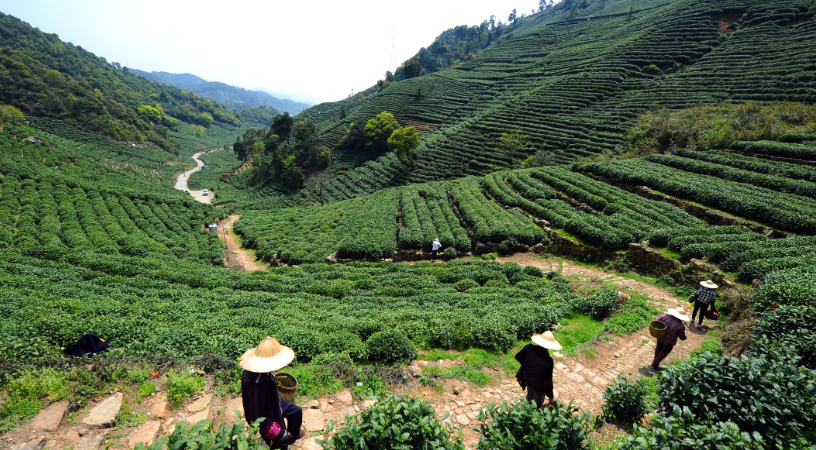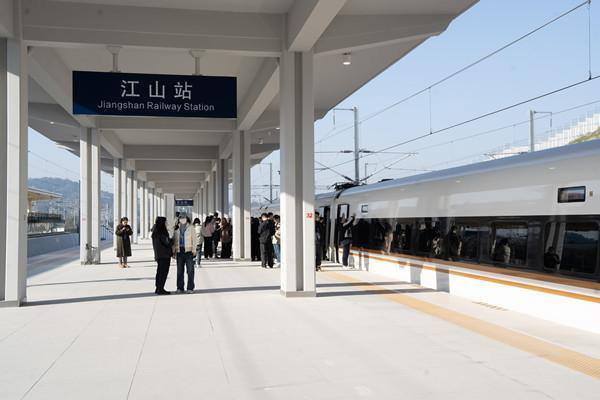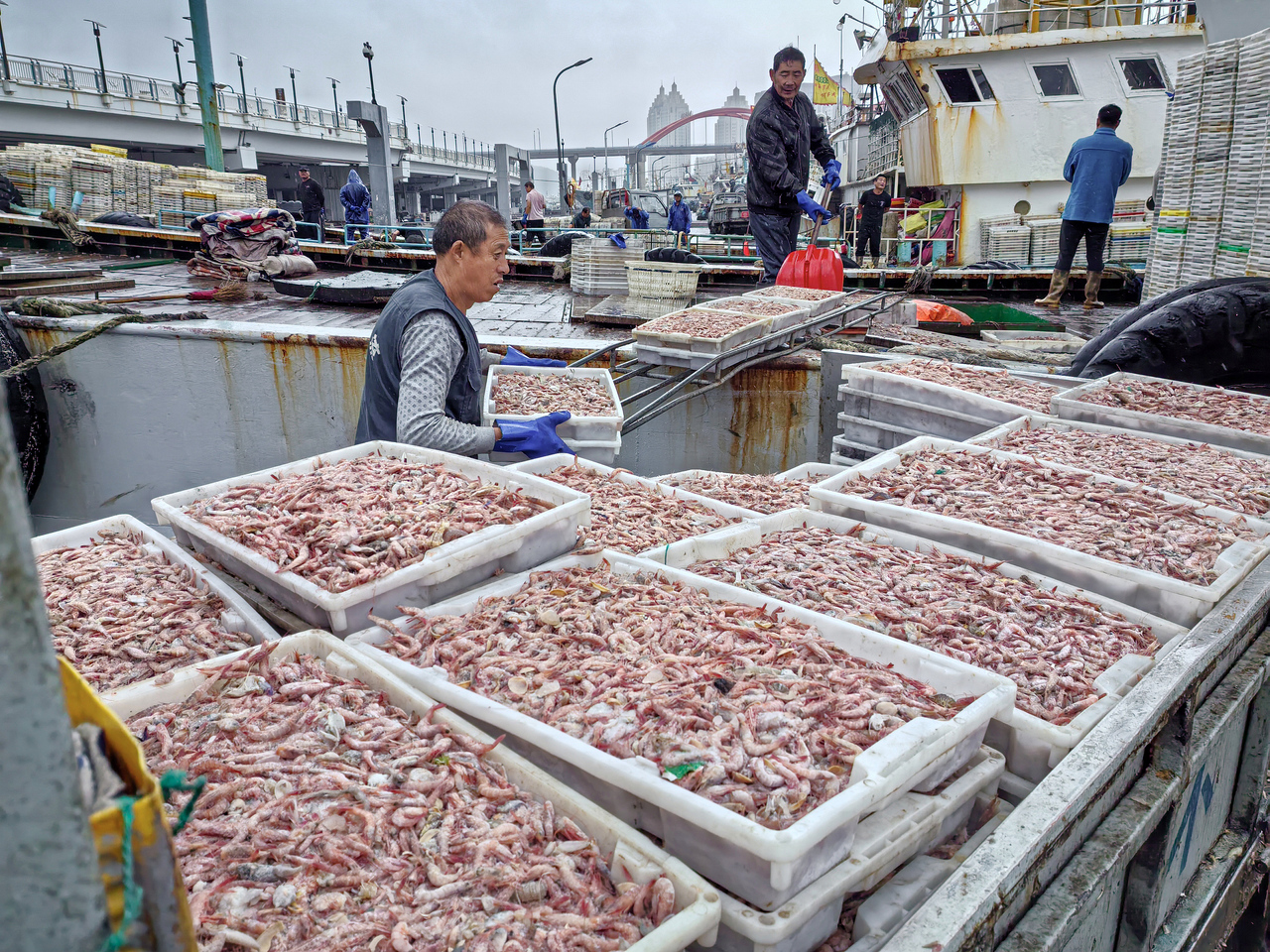
(Photo credit: VCG)
For the next couple of days, the sun will still be shining brightly upon Hangzhou with the city's highest temperature reaching 36 degrees Celsius. Longwu Town, which, from a bird's view is now occupied by well-arranged long striped lush green tea bushes, is extremely refreshing and pleasing to the eye. For some outdoor fun in summer and learn some about tea culture, the following four itineraries are not to be missed.
Nature
North Entrance of Jiujie Street (pinyin: jiu jie bei kou; simplified Chinese: 九街北口) --> Cimu Bridge Cultural Auditorium (pinyin: ci mu qiao wen hua li tang; simplified Chinese: 慈母桥文化礼堂) --> Longmenkan Village (pinyin: long men kan cun; simplified Chinese: 龙门坎)
Inside the Longmenkan Village of Longwu Tea Town, there is a pool called White Dragon Pool (pinyin: bai long tan; simplified Chinese: 白龙潭). The pool enjoys quite popularity and people into natural and ecological tour will definitely fall for it.
The renowned poet Li Bai from the Tang Dynasty (618-907) once composed a poem to praise its beauty, and the White Dragon Waterfall at the pool is the largest waterfall landscape in Hangzhou suburban areas. Besides enjoying the fine craftsmanship of nature in White Dragon Pool, the place also offers many wonderful places for foodies to eat to their hearts' content.
The Qing Lan She (青兰社) in Longmenkan Village has the most traditional local delicacies of Longwu, including crispy fried spring rolls, fresh and tender deep-fried prawns, refreshing celeries with smoked bean curds, and seasonal fruits such as bayberries and plums, as well as exquisite and tantalizing handmade snowflake flaky pastry (pinyin: xue hua su; simplified Chinese: 雪花酥).
The private restaurant is run by a local and has been well received by tourists from far and near.
Art and Culture
South Entrance of Jiujie Street (pinyin:jiu jie nan kou; simplified Chinese: 九街南口) --> entrance of Xihuchachang Village (pinyin: xi hu cha chang cun cun kou; simplified Chinese: 西湖茶场村村口) --> Dagong Garden (pinyin: da gong yuan; simplified Chinese: 达贡园)
Rongyun Wood Workshop (pinyin: rong yun mu gong fang; simplified Chinese: 柔云木工坊) on Jiujie Street, a combination of such elements as wood, handicrafts and tea art performances, can be said as the holy place of culture and art.
People who know the ropes about carpentry can exchange thoughts with the workshop owner.
There will be handicrafts course from time to time. So beginners can experience making traditional chopsticks and learn about Chinese culture.
As a culture and art itinerary, just one handicraft workshop is not able to do the trick. Along the itinerary are scattered a wide variety of handicrafts and culture creative experiencing projects and people can also have an in-depth exploration of Changdai Village (pinyin: chang dai cun; simplified Chinese: 长埭村) to seek out the many interesting art workshops hidden on zigzag paths to experience the fun of making handicrafts.
The Baihulin Handicrafts Garden (pinyin: bai hua lin shou zuo yuan; simplified Chinese: 白桦崊手作园) at the ending point of the itinerary near Dagong Garden is one of them. Its "Yin Yu Shan (Hidden Among Mountains; 隐于山)" Culture and Creative Studio offers lots of ways for you to relax, including outdoor barbeque, culture and art handicrafts experiencing, coffee and afternoon tea, films and music, etc.
Slow Life
North Entrance of Jiujie Street --> parking lot of Shangchengdai Village (pinyin: shang cheng dai cun ting che chang; simplified Chinese: 上城埭村停车场) --> Giant Tea Pot (pinyin: da cha hu; simplified Chinese: 大茶壶)
Life in cities is fast-paced, and if you want to slow your pace down, this itinerary may satisfy your need.
There are almost a hundred guesthouses in Shangchengdai Village. Most of them are surrounded by mountains full of tea bushes. These guesthouses are not only full of natural charm but also hospitality. Among them, the silver level (the third-highest level of guesthouses according to a guesthouse evaluation system now in practice in China) guesthouse, "Mao Zai Long Wu (Idling Away in Longwu; 猫在珑坞)" has been given the honor of provincial demonstration guesthouse.
You can stay at a guesthouse run by the locals, stroll around tea gardens in the morning, then return to the guesthouse to rest and sip a cup of tea when the sun sets to experience the slow life among the primitive environment on sweltering summer days.
The nearby Xishan Forest Park is also an ideal place to visit on summer days. With an area of 1381 hectares, the forest coverage rate of Xishan is up to 96.7 percent and the annual average temperature here is 16.2 degrees Celsius. It's definitly a natural oxygen bar and a perfect summer resort.
Sports
North Entrance of Jiujie Street --> parking lot of Hejia Village Villagers Committee (pinyin:he jia cun cun wei ting che chang; simplified Chinese: 何家村村委停车场) --> Cycling Park (pinyin: qi xing gong yuan; simplified Chinese: 骑行公园)
If these are all about relaxation, sports enthusiasts may find them less appealing. Here comes the exclusive itinerary for sports lovers.
Along the route, you will come across Guangmingsi Reservoir, which is nicknamed "the *Little Jiuzhaigou Valley in Hangzhou". The experience of having a picnic under the shade of a tree near the reservoir after cycling is more than relaxing.
*Jiuzhaigou Valley is an extremely beautiful attraction boasting great eco-environment in China.
Sightseeing Bus Tips
Hours: The first bus departs at 10:00 and the last at 17:00, and bus intervals depend on the number of passengers on that day.
The place to take the bus: the plaza of walking street opposite Wanrong Hall in Jiujie Street, Longwu Tea Town 龙坞茶镇九街万融堂对面的步行街广场
Reminder: Currently the sightseeing bus No. 1, 2 and 3 routes are available. No. 4 is under maintenance and for the safety of tourists, it is now closed.
(Executive Editor: Yijun CHEN)




